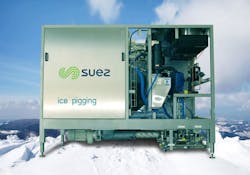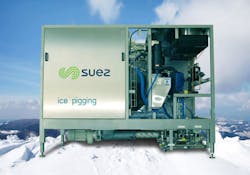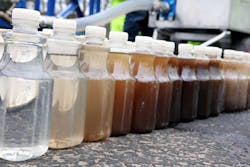Developed in the University of Bristol, ice pigging has since been commercialised and is being used in 11 countries to help to clean drinking water pipelines. How is the process developing and now also being used in the oil and gas sectors?
By Matthew Stephenson
If you’re a professional in the water industry you might have heard of Ice Pigging - a method of cleaning pipes with ice. The technology has now been fully adopted and is in use in the water and wastewater sectors in 11 of the world’s most advanced nations, including Australia, Sweden, Italy, Spain, Japan, UK, Ireland, USA, Holland, CZ Rep, Canada and Chile.
At a recent water industry event in Sweden - a country new to Ice Pigging - approximately 300 water industry professionals from water authorities and their stakeholders came to see Ice Pigging being performed over three days.
Commercialising the technology
The method was first invented at the University of Bristol, UK, where Professor Joe Quarini, head of mechanical engineering had a genuine ‘Eureka!’ moment while pondering ways of reducing water used in cleaning processes in the food industry.
The rights to the technology in the water industry were acquired by Suez in 2010, via subsidiary Agbar Environment UK, the commercial arm of the Barcelona water company AGBAR. AGBAR were also owners of Bristol Water, responsible for supplying drinking water to a population of over one million in South West England.
It was Bristol Water who made the leap of faith with the University of Bristol to industrialise the process and bring it from laboratory to be tested in full scale on their own network. Many water companies at the time perceived the process as risky and question whether the pipes crack with cold shock, would it block customer supply pipes and would it actually work?
In 2014 Suez brokered a deal with the University of Bristol to extend its ownership of the technology to cover all industries. Despite a number of corporate name changes, the heritage of the Suez Ice Pigging offer has remained consistent, with a number of original key staff from Bristol Water still involved with the process and its commercial and technical development. Six PhD graduates from the university with specialisms in ice pigging have since joined Suez.
Technical developments
Key technical developments that have taken the technology forward include the ability to clean very large pipes - now up to 700mm in diameter. This is only possible with the use of very large quantities of ice slurry, with a number of UK water companies requesting ice loads of 35,000 litres in a single operation.
Ice making capacity in UK - the territory with the highest output - is now 125 tonnes of ice per week, a major increase on the initial capacity of 35 tonnes per week when the process was first introduced. This scaling up has only been possible by use of new methods of ice slurry production, since ice slurry has a shelf life and can only be made within 24 hours of the planned operation.
Since the original ice delivery truck was put on the road in 2009 there have been many improvements to the design and function of ice delivery equipment. Despite greater control over ice quality, there has been the introduction of mechanisms to rejuvenate older ice, which tends to form larger ice crystals as it ages.
Another major development in ice delivery equipment has been a reduction in the cost to roll out the service. Quoted prices are now on average 21% lower than in 2010, despite inflation, thanks to cost reductions introduced with the scaling up of the equipment and teams required to deliver the specialist service.
Case studies
Northumbrian Water and Affinity Water are two UK water companies that have used the technology extensively and over a number of years. The commonality between these two companies is that before adopting the process, both had a recognised need to control sediments within their pipes.
The former used ice pigging instead of an invasive alternative process to reduce pipe interruptions from a few weeks to a few hours. Several benefits were realised from the process. For Northumbrian, there was a significant reduction in disruption to road traffic compared with invasive techniques of pipe cleaning where major enabling works are required, and minimal interruptions to water supply as most ice cleaning operations were performed in a four hour window during the night.
Another example is Yarra Valley Water in Melbourne, Australia, is one of the first to use ice pigging, and for some time were the largest user of the technology in the world cleaning 400km of drinking water pipe each year. The utility recently published a detailed ‘before and after’ study showing the effects on water quality complaints after 12 months of Ice Pigging, entitled The Performance of Ice Pigging. The study concluded that ice pigging caused a significant reduction in water quality customer complaints.
In the UK, one company who has not yet published results but report similar benefits showing water quality complaint reductions of 18% year-on-year, and 40% over three years. Another UK company reports a 77% reduction in complaints following a three month project to clean strategic mains. It is only after some years that the benefits of technologies like ice pigging can be appreciated in the wider context of a developing water industry with ever increasing consumer expectations.
The future
Ice pigging was initially launched as a commercial service to the water industry. Many other applications for the core solution have been tabled since the technology was patented more than 10 years ago. For example, the food industry has strong potential for the application of ice pigging as a way of improving processing efficiency. Within the factories of large food producers, where multiple products with different varieties and flavours are produced, lost product at the point of product changeover can often have high value, create high volumes of effluent, and use high volumes of water when cleared from pipes. Ice pigging offers the potential to save much of this previously lost product and in the process reduce water consumption and effluent production. The drivers in the food industry remain strong.
The oil sector is the third key industry where the technology appears to have a strong pull. As with the water sector, the low risk of using ice to clear pipes is an attractive proposition for an industry that operates with an inherently hazardous and valuable liquid product.
Following testing for one of the world’s largest oil companies, projects are now being studied that will inevitably stretch the technical limits of the technology. This includes projects involving delivery of ice pigging on oil platforms, the decommissioning of sub-sea oil pipelines and cleaning pipes in some of the remotest parts of the world.
The experience with ice pigging is that many industries usually describe themselves as conservative, risk-averse and slow to change, and probably with good reason. At the same time the same industries often show great interest in innovation as a means of saving money, time and effort. The challenge is to recognise the paradox that this presents, remain patient with early adopters, and to have the legs to stay in the game long enough until the innovation becomes the norm.
Matthew Stephenson is ice pigging unit director for Suez.
More Water & WasteWater International Archives Issue Articles




